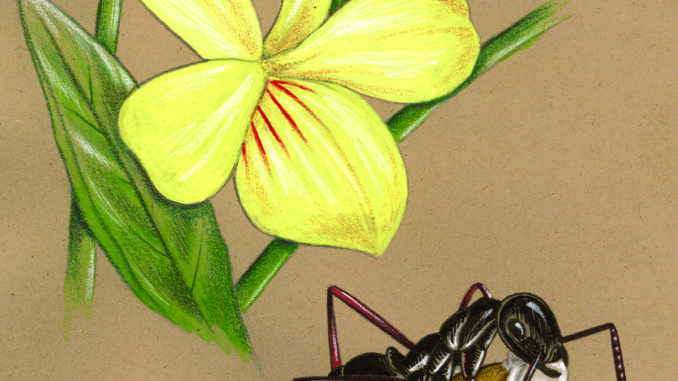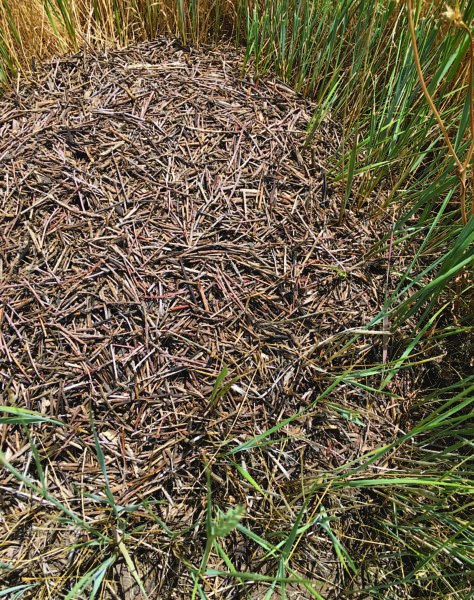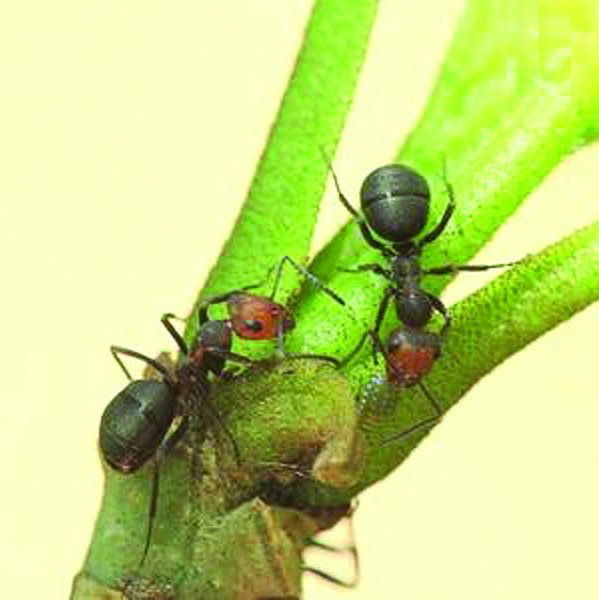
Bio Bites
By R. Gary Raham
A biologist-artist’s ruminations about our roles in a science-inspired world
Stumbling over the joys of science at Soapstone
The joy of science may strike without warning, perhaps when you nearly trip over a mound of easily angered ants. This happened to me while co-leading a backcountry hike to the Lindenmeier homestead on Soapstone Prairie. Four of us lead the hike a couple of times each year: Brian Carroll, who has acquired expertise in archaeology and homesteading, David Morse, a geologist, Boyce Drummond, a field ecologist, and me, a biologist-artist. We pontificate about nature and our human connection to it. Between us we have close to 300 years of collective experience—which seems impressive at first blush—but nature always finds ways to humble us with its astonishing variety.
Boyce and I talk about harvester ants (Pogonomyrmex occidentalis) because of their abundance and importance on the prairie. The ants bore into the soil, creating a network of tunnels six feet deep. Their excavations dot the landscape with tan-colored mounds of rubble. The ants form many intricate, mutually beneficial liaisons with plants. I like to talk about the wild violet, a spring flower that times the release of its seeds so that ants are more apt to harvest them. The ants will eat the fatty bribes the plant produces on the outside of the seed, but drop the seed to germinate elsewhere whereas rodents will eat the entire seed.
But this year some different ants surprised us. Black and red ants scurried over a mound of plant debris that looked like the thatch on a grass hut. What kind of ants were they? How did they fit within the web of prairie life? Scientists love asking such questions—and figuring out practical ways to answer them.

Boyce, always prepared for encounters with insects in the field, aspirated some ants from the mound into a vial. That technique involves sucking them up through a straw-like cylinder into a tube. He coughed and sputtered. First clue: these ants belonged to the genus Formica, known for squirting formic acid as a defense against nosy mammals, including scientists. Boyce later keyed them down to Formica obscuripes, a thatching ant more common in wetter, moister habitats. Unlike harvester ants, thatching ants prey on other insects. Sometimes they “milk” aphids for the sweet honeydew that oozes from their rear ends.

The game was afoot! We both starting checking scientific literature—on the web, and tucked into obscure books and scientific papers. I found that in Michigan black cherry plants (Prunus serotina) release chemicals three weeks after buds open that attract F. obscuripes. That coincides with the only time that eastern tent caterpillars (Malacosoma americana) are small enough that ants can eat them. A coincidence or a way black cherry plants can protect their budding futures? If the latter, might our prairie thatcher ants have similar relationships with Mountain Mahogany or skunkbush that also suffers from tent caterpillars? That’s a valid scientific question that can be tested through observation and experimentation.
Brian, David, Boyce, and I all enjoy sharing our experience, and what we’ve learned from “standing on the shoulders of giants,” as Sir Isaac Newton once famously remarked. But the real joy of practicing science skitters along our spines like a surprised squirrel along a tree branch. It is the excitement of discovering—sometimes literally stumbling into—something new and unexpected. Something that promises to answer questions that we had not thought to ask before.
Support Northern Colorado Journalism
Show your support for North Forty News by helping us produce more content. It's a kind and simple gesture that will help us continue to bring more content to you.
BONUS - Donors get a link in their receipt to sign up for our once-per-week instant text messaging alert. Get your e-copy of North Forty News the moment it is released!
Click to Donate

1 Trackback / Pingback
Comments are closed.